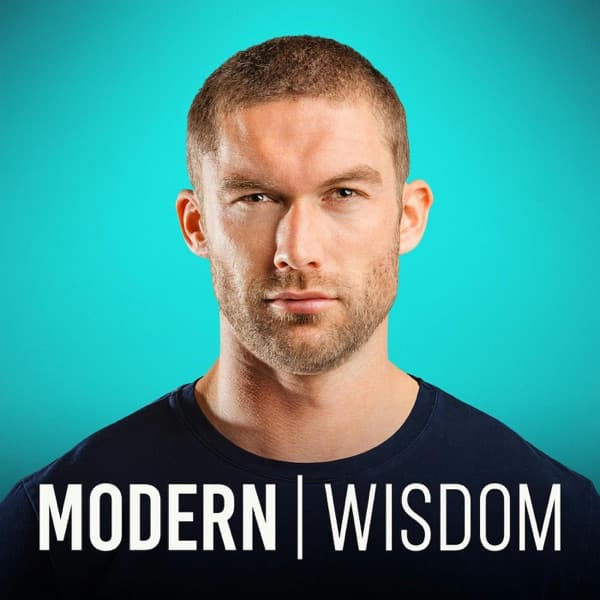Modern Wisdom: The discussion explores the challenges and implications of people-pleasing, emphasizing the importance of setting boundaries and self-advocacy.
How I Built This with Guy Raz: The episode features entrepreneurs discussing business challenges and growth strategies, focusing on overcoming imposter syndrome and scaling businesses effectively.
Lenny's Podcast: Product | Growth | Career: The pod model at Gong involves small, cross-functional teams working closely with design partners to ensure high product success rates.
Modern Wisdom - #884 - Nick Pollard - How To Stop Being Such A People Pleaser

The conversation delves into the psychological and societal factors that contribute to people-pleasing behaviors, highlighting how social media and societal comparisons exacerbate this issue. It discusses the internal struggle of feeling 'not enough' and how this leads to prioritizing others' needs over one's own. The dialogue also covers the childhood roots of people-pleasing, where individuals learn to seek validation through pleasing others due to family dynamics. Practical strategies for overcoming people-pleasing include setting boundaries, learning to say no, and engaging in self-invention through play. The importance of recognizing and addressing the guilt associated with prioritizing oneself is emphasized, along with the need to redefine personal values and boundaries. The discussion also touches on the challenges faced by successful individuals in breaking free from people-pleasing patterns, noting that while they may have more resources, they also have more at stake. Ultimately, the conversation encourages embracing authenticity and self-love as pathways to healthier relationships and personal fulfillment.
Key Points:
- People-pleasing is driven by societal comparisons and a feeling of inadequacy, often rooted in childhood experiences.
- Setting boundaries and learning to say no are crucial steps in overcoming people-pleasing behaviors.
- Engaging in self-invention and play can help individuals rediscover their identity and preferences.
- Successful people-pleasers face unique challenges due to their established patterns and stakes, but breaking these patterns can lead to significant personal growth.
- Embracing authenticity and self-love is essential for building healthier relationships and achieving personal fulfillment.
Details:
1. 🎭 The Trap of People-Pleasing: An Introduction
- People-pleasing often leads to neglecting one's own needs, resulting in burnout and decreased personal satisfaction.
- Many individuals engage in people-pleasing due to a desire for acceptance and fear of rejection, often compromising their own values.
- The behavior can create a cycle of stress and anxiety, as the constant need to fulfill others' expectations becomes overwhelming.
- People-pleasing can negatively impact professional environments, leading to reduced productivity and increased resentment among employees.
- Breaking the cycle of people-pleasing requires setting clear boundaries and practicing self-assertion, which can improve mental health and job performance.
2. 🌐 Social Media and Self-Comparison: A Societal Shift
- Social media creates an environment where individuals constantly compare themselves to others, shifting focus from internal self-satisfaction to external validation.
- The societal norm has shifted to measuring self-worth against often unattainable standards set by influential figures with millions of followers and significant financial success.
- There is a prevalent idea that one must be dissatisfied with their current state to strive for improvement, fostering a culture of self-comparison and people-pleasing.
- A study by the Royal Society for Public Health found that Instagram is the most detrimental social networking app for young people's mental health, citing increased levels of anxiety and depression.
- Psychological research indicates that frequent use of social media correlates with higher rates of depression and anxiety, especially among teenagers.
3. 🤝 People-Pleasing and Self-Worth: The Internal Struggle
- People-pleasing is fundamentally about managing perceptions and placing others' needs above one's own, reflecting an ongoing struggle with self-worth.
- This behavior often stems from a deep-seated belief of inadequacy, driving individuals to constantly strive for acceptance by meeting unrealistic expectations.
- The roots of people-pleasing frequently trace back to childhood, characterized by one highly involved parent and another who is either abusive or emotionally absent, creating a dynamic that fosters people-pleasing tendencies.
- People-pleasers typically develop mechanisms like striving to make others happy or maintaining peace to avoid feelings of abandonment, frequently due to enmeshment issues with an overly involved parent.
- This pattern often includes one parent who positions the child as the center of their world, while the other parent remains distant, contributing to the internal struggle of self-worth.
4. 🔍 Identifying People-Pleasers: Behaviors and Consequences
- People pleasers often exhibit dishonesty, such as saying 'yes' when they mean 'no'. This behavior stems from a lack of self-awareness about its impact on personal well-being, rather than malicious intent.
- Common consequences for people pleasers include a lack of free time due to overcommitting, financial strain from prioritizing others' needs over their own, and feelings of loneliness and misery.
- These individuals often have perpetually full calendars and low personal financial resources because they prioritize others' needs above their own.
- Social isolation is another consequence, as relationships may become transactional or one-sided, leading to exclusion from casual social gatherings like barbecues.
- To better recognize people-pleasing behaviors, observe patterns of overcommitment, financial sacrifices, and limited social invitations, which indicate a prioritization of others over oneself.
5. 🧠 The Psychology of Self-Identity and Play
- Chronic people-pleasing behaviors are often mistaken for altruism but can lead to neglecting one's own needs, ultimately affecting self-identity.
- Authentic consent and boundaries are crucial, as highlighted by the phrase "If I can't trust your no, I can't trust your yes," emphasizing the importance of genuine decision-making.
- The psychological drive for people-pleasing includes seeking validation and a dopamine rush from being agreeable, which can result in avoiding necessary self-advocacy.
- Therapeutic insights suggest that people-pleasers endure unnecessary personal suffering by avoiding short-term discomfort, thus undermining long-term well-being.
- Recognizing people-pleasing tendencies is critical for personal growth, as they can be deeply ingrained in one's self-identity, often revealed through reflection and therapy.
- The connection between people-pleasing and self-identity underscores the need to balance personal and others' needs, ensuring self-care and authentic interactions.
6. 🔄 The Journey of Self-Discovery: Overcoming People-Pleasing
- Initiate a seven-day challenge where you say 'no' to everything to confront fear of rejection and manage people-pleasing behaviors effectively.
- This challenge includes a 90-second window to reconsider your decision, helping you become comfortable with the initial discomfort of saying 'no'.
- Frequent practice of saying 'no' shifts your default response, thus freeing up your time for more fulfilling activities.
- The effectiveness of this practice is backed by James Clear, emphasizing frequency over duration in learning new habits.
- Strive to distinguish between being agreeable and being a people-pleaser, aiming for authentic responses that reflect true intentions.
- Recognize that people-pleasing involves a lack of authenticity, which can be perceived as dishonest or inauthentic, impacting personal integrity.
- Utilize analogies, such as not eating peanuts if allergic despite social pressures, to prioritize authenticity and personal well-being over appeasement.
7. ⏳ The Balance of Joy and Meaning: Finding Fulfillment
7.1. The Importance of Play in Self-Identity
7.2. Adults Need Play for Self-Invention
7.3. Balancing Joy and Meaning
8. 💪 The Costs of People-Pleasing: Physical and Emotional Wellbeing
8.1. Delayed Gratification and its Consequences
8.2. Impact on Flexibility and Joy
8.3. Psychological Effects of People-Pleasing
8.4. RP Hypertrophy App Advertisement
9. 🎢 The Cycle of Shame and Addiction: Breaking Free
- Addicts often use substances to bury feelings of toxicity and lack the ability to prioritize themselves, leading to a lack of joy.
- An example shared involves a person who, despite financial stability post-rehabilitation, struggled to buy a TV for personal enjoyment due to a lack of self-worth.
- The individual required intervention from a therapist, highlighting a common struggle among addicts to make decisions for personal happiness.
- This scenario illustrates a broader issue where individuals find it challenging to experience joy, celebrate achievements, or ask for and receive what they need.
- To break this cycle, individuals must learn to prioritize their own needs and recognize their worth, often requiring therapeutic intervention and support from others.
- Building a supportive community and setting achievable goals can help individuals in recovery experience joy and satisfaction.
- Addressing the root cause of shame through therapy and self-awareness is crucial in overcoming addiction.
10. 🌱 Establishing Healthy Boundaries: A Guide
- Physical well-being is often neglected as personal needs are deprioritized in favor of others, leading to poor diet, lack of exercise, and overall health decline.
- Emotional well-being suffers as people pleasers constantly feel behind and unable to measure up, causing stress and a persistent sense of inadequacy.
- Financial strain is common among people pleasers who give away money to others, often leading to depletion of personal resources and increased financial instability.
- On average, people pleasers experience burnout by age 38, impacting their ability to function effectively.
- Entrepreneurs are particularly vulnerable to people pleasing, especially in the early stages of business development, due to the pressure to satisfy customer demands.
- High success levels among people pleasers often do not correlate with happiness; instead, they experience growing dissatisfaction despite rising income.
11. 🧩 Gender Differences in People-Pleasing: A Closer Look
11.1. Lack of Boundaries and Self-Image Issues
11.2. Polarized Thinking and Balanced Identity
11.3. Emotion-Based Decision Making
11.4. Recognizing Resentment and Intent
11.5. Gender Differences in People-Pleasing
12. 🚹 Men and People-Pleasing: Societal Pressures
- Men internalize people-pleasing issues, often labeling themselves negatively, such as "I'm a piece of shit," contrasting with women who externalize it as others' problems.
- An extra level of shame exists for men around being pliable, due to societal expectations of stoicism, self-sufficiency, and assertiveness.
- Societal narratives have redefined masculinity as a toxic trait, creating a paradox where men are deemed toxic if they don't exhibit masculine traits.
- The 'nice guy' syndrome often arises from being raised in predominantly female environments, lacking strong male role models.
- Men encounter a no-win situation when expressing their identity, caught between being labeled as either useless or toxic.
- A study of 1,000 men showed 68% felt societal pressure to conform to traditional masculinity, leading to internal conflicts and shame.
- Examples of men in therapy highlight struggles with expressing vulnerability due to fear of judgment as weak or unmanly.
13. 🔄 Navigating Emotional Complexity: Men and Vulnerability
- Men often experience resentment and anger due to societal pressures to conform to certain standards, leading to issues like addiction and mental health struggles.
- The current psychological support systems are not tailored to men's needs, as many men do not find traditional methods of expressing emotions, like crying or talking about feelings, helpful.
- There is a need for purpose-driven approaches to mental health for men, focusing on actionable steps rather than emotional expression alone.
- The societal expectation for men to be both strong and emotionally open creates a challenging balance, which can lead to internal conflict about vulnerability.
- Men fear being perceived as weak or incompetent if they express vulnerability, leading to a reluctance to open up, which can negatively impact mental health.
- The psychological struggle involves managing the full spectrum of emotions without feeling overwhelmed or losing control, which is often at odds with traditional masculine ideals.
- There is an acute sense of shame associated with male emotional pliability, which can exacerbate feelings of inadequacy.
- To address these issues, mental health approaches should include practical strategies that align with men's experiences and societal roles, potentially incorporating activities that naturally engage men, like sports or group projects.
14. 🔍 Self-Advocacy and Boundaries: Embracing Change
- Emotional intelligence training is essential as both genders struggle to handle each other's emotions unless exceptionally well-trained.
- Having fewer than three close friends of the same gender can indicate people-pleasing tendencies and difficulty in forming meaningful connections.
- People-pleasers often feel safer with the opposite gender, a pattern that may require deeper exploration.
- Despite its evolutionary importance, advocating for personal needs is challenging, highlighting a disconnect between survival instincts and social behavior.
- Rejection is perceived as abandonment by people-pleasers, making self-advocacy particularly daunting and reinforcing fears of losing acceptance and love.
- The fear of being disliked is a major barrier to setting boundaries, reflecting deep-seated fears of losing acceptance and love.
- Early experiences of unmet needs make self-advocacy feel dangerous, leading to fears of abandonment or exacerbating conflicts.
15. 🧠 The Struggle for Self-Identity: Rediscovering Preferences
- Individuals often find it difficult to advocate for their own needs due to upbringing in environments lacking transparent communication, leading to passive aggression and misunderstandings.
- Persistent people-pleasing behavior can cause a loss of self-identity, where personal preferences and beliefs become unclear, complicating self-advocacy.
- The line between agreeableness and people pleasing blurs when personal desires are consistently suppressed, resulting in an inability to express authentic opinions or interests.
- In corporate settings, people pleasing can lead to career stagnation. An example is given where someone remained in a subordinate position due to fear of asserting personal beliefs, eventually leading to burnout.
- Rediscovering self-identity requires acknowledging the need for assertiveness, which is challenging when preferences are buried under a facade of appeasement.
- Self-reflection activities like journaling can aid in identifying true interests and opinions, initiating the process of reclaiming self-identity.
16. 🎯 Building Self-Trust: Aligning Actions with Intentions
16.1. Identifying Disconnection from Success
16.2. Self-Perception and Luck
16.3. People Pleasers and Depth
16.4. Aligning Self-Perception
16.5. Balancing Generosity and Self-Care
17. 💬 Communication and Boundaries: Techniques for Assertiveness
- The concept of guided missiles is used as an analogy for personal growth, emphasizing course correction and aiming away from negative targets to achieve life goals.
- Starting with physical activities like going to the gym is recommended for clients to channel anger and improve well-being, leading to enhanced life satisfaction.
- Addressing feelings of inadequacy involves recognizing emotions, questioning their origins, and reframing negative self-talk through curiosity rather than judgment.
- Engaging with shared experiences and seeking community support can help individuals overcome people-pleasing tendencies and discover their unique interests and strengths.
- Sitting with and understanding emotions is crucial, as feelings of insufficiency can lead to self-sabotage, particularly for those with people-pleasing behaviors.
- Practical strategies involve walking and reflective questioning to address anxiety and negative thought patterns, helping to replace them with constructive beliefs.
- Embracing mistakes and learning to enjoy experiences can reduce fear and pressure, as advised by mentors like Dr. Glover.
18. 🗺️ Crafting a Bill of Rights: Personal Values and Boundaries
18.1. Understanding Personal Beliefs and Reinforcement
18.2. Setting Boundaries Based on Values
18.3. Creating a Personal Bill of Rights
19. 🎯 Maintaining Boundaries: Habits and Routines
19.1. Preparation and Operating Principles
19.2. Learning and Competence
19.3. Setting Boundaries and Personal Growth
19.4. Maintaining Boundaries and Habits
20. 🎭 Facing Fear: Embracing Courage and Bravery
20.1. Daily Routine and Mindfulness
20.2. Boundaries and Assertiveness
20.3. Decision-Making Under Pressure
21. 💡 Embracing Loneliness: The Path to Self-Discovery
21.1. Developing Courage and Managing Fear
21.2. Setting and Maintaining Boundaries
21.3. Overcoming Guilt and Self-Importance
21.4. The Power of Saying No
21.5. Loneliness as a Catalyst for Personal Growth
21.6. Navigating and Embracing Loneliness
22. 📚 Resources and Reflections: Embracing Change
- Building self-confidence comes from personal commitments and following through, rather than external achievements.
- The journey from self-doubt to self-assurance involves small realizations and actions, leading to significant life changes.
- Facing setbacks, like toxic relationships, is part of personal growth and requires course correction.
- Understanding whether people love you for who you are or what you do is crucial for self-worth.
- Self-trust is built by consistently fulfilling personal commitments, similar to trusting a reliable friend.
- Triggers and emotional responses are personal responsibilities and need to be managed personally.
- The balance between trauma and adversity is essential; not every discomfort is a trigger.
- Evaluating relationships and deciding when to let go of toxic people is important but should not be rushed.
- Successful people pleasers often face burnout and need to redefine relationships with family and money.
- Breaking the habit of people-pleasing can lead to significant personal transformations when true self-assurance is achieved.
- Honesty in personal relationships enhances love and connection, akin to the imperfection that makes Velcro effective.
- Falling in love with oneself and allowing people to come and go naturally leads to a fulfilling life.
- Recommended books for personal growth include 'Not Nice' by Aziz Gazipura, 'No More Mr. Nice Guy' by Dr. Robert Glover, and 'The Road Less Traveled' by M. Scott Peck.
How I Built This with Guy Raz - Advice Line with Brett Schulman of CAVA (July 2024)

The episode features Guy Raz and Brett Schulman discussing business challenges with entrepreneurs. Devin Strahan shares his journey of creating a spiked root beer business after a career pivot. He faces imposter syndrome and logistical challenges in scaling his business. Brett advises on focusing strengths and seeking mentorship. Sophia Bowden, founder of Little Me Allergy, seeks advice on expanding her niche allergy accessories business. The discussion emphasizes leveraging partnerships and exploring retail opportunities. Sean Murray of Rootless Coffee Company discusses growth funding and scaling strategies. Brett highlights the importance of focusing on core business channels and seeking experienced advisors. The episode underscores the value of perseverance, strategic focus, and leveraging networks for business growth.
Key Points:
- Focus on core strengths and prioritize business channels for effective scaling.
- Seek mentorship and advice from experienced business leaders to navigate challenges.
- Leverage partnerships and collaborations to expand market reach.
- Explore retail and trade show opportunities for niche products.
- Perseverance and strategic focus are crucial for overcoming business challenges.
Details:
1. 🔊 Wondery Plus Introduction
- Wondery Plus subscribers have the advantage of accessing 'How I Built This' episodes earlier than non-subscribers.
- Subscribers can enjoy an ad-free listening experience, enhancing user engagement.
- Wondery Plus is accessible via the Wondery app or Apple Podcasts, providing multiple platform options for users.
2. 🧠 AI and Grammarly as a Writing Partner
2.1. Grammarly's Versatile Writing Support
2.2. Security and Suitability for Business
3. 🏆 NerdWallet's Financial Product Awards
- NerdWallet reviewed over 1,100 financial products, including credit cards and savings accounts, to identify the top options available.
- The 2025 Best of Awards presents a curated list of the best financial products, saving consumers time and effort in researching options.
- The awards aim to simplify the process of selecting financial products by providing a pre-evaluated list of the best choices.
- The evaluation criteria included factors such as customer satisfaction, financial benefits, and unique features offered by each product.
- Examples of categories reviewed include credit cards with the best rewards, highest interest savings accounts, and most user-friendly budgeting apps.
4. 🏃♂️ Fitness and Health with Lingo
- Lingo is a bio-wearable device that measures glucose levels from the back of your arm, helping to understand your body's response to food and improve metabolism.
- Available without prescription, starting at $49 for a two-week plan, with a 10% discount using code H-I-B-T at hellolingo.com.
- The device is considered a game changer in fitness for its ability to provide real-time metabolic insights, enabling personalized dietary adjustments.
5. 💌 Klaviyo's Digital Marketing Solutions
- Klaviyo offers a comprehensive digital marketing platform that integrates email, SMS, and review functionalities, enabling businesses to create cohesive marketing strategies.
- The platform is designed to enhance customer engagement by providing tools that allow businesses to build smarter and more personalized digital relationships.
- Klaviyo's emphasis on 'making every moment count' highlights its focus on optimizing customer interactions for better retention and satisfaction.
- For detailed insights and case studies on how businesses have successfully utilized Klaviyo's features, visit klaviyo.com.
6. 🎉 Holiday Greetings and Advice Line Intro
- Brett Shulman, co-founder of Kava, offers crucial insights into overcoming business scaling challenges, emphasizing strategic growth and adaptation.
- Listeners are encouraged to internalize New Year's themes, focusing on personal and professional development, resilience, and optimism.
- The episode underscores the importance of embracing continuous learning and joy as foundational elements for success in the upcoming year.
- Shulman's advice includes practical strategies for navigating common pitfalls in business expansion and fostering an environment conducive to growth.
- Concrete examples from Kava's own journey illustrate how strategic planning and adaptability can lead to significant improvements in operations and revenue.
7. 📞 Brett Schulman on Business Growth
- Guy Raz introduces a platform for solving business challenges through personalized insights from legendary founders, such as Brett Schulman.
- Listeners can call 1-800-433-1298 or send a voice memo to receive tailored business advice.
- The platform addresses specific business issues, offering strategic advice on challenges like scaling operations or improving customer engagement.
- Sign up for a newsletter at GuyRoz.com to receive curated insights from world-renowned entrepreneurs, enhancing your business growth strategies.
8. 💡 Overcoming Imposter Syndrome in Business
- Brett Schulman, co-founder of Kaba, successfully scaled the business from a single sit-down restaurant to a chain of hundreds of fast casual restaurants by leveraging the growing consumer interest in fresh and healthy food.
- The transition to a fast casual format was a strategic decision aimed at making fresh and healthy food more accessible to a larger audience, which was identified through careful market analysis and understanding customer needs.
- Listening to customer feedback and aligning with market demand were key components in identifying opportunities for expansion.
- Effective prioritization was crucial in the scaling process; Schulman emphasized that choosing what not to do is as important as choosing what to do, thus focusing on the company's strengths and core competencies.
- The strategic decision-making involved in scaling included evaluating market trends, customer preferences, and the competitive landscape to ensure the business's growth trajectory aligned with its goals.
9. 🌟 Scaling a Business and Focusing Resources
- Devin Strahan transitioned from being a private chef and owning a healthy muffin company to creating spiked root beer after being inspired by the craft beer market.
- Devin's previous business experience included running a muffin company for 13 years, which closed down when a major client went under, leading to significant financial changes.
- His entrepreneurial spirit was reignited while working at a liquor store, influenced by the creativity in the craft beer market despite not being a beer drinker.
- The concept of spiked root beer was developed as an innovative product catering to both his and his children's love for root beer, converting it into an adult beverage.
10. 📈 Marketing Strategies for Niche Products
- The business initially began with home experimentation, transitioning into a wine-based product to navigate regulatory challenges more easily.
- A strategic pivot led to the development of a diverse range of eight root beer-based flavors, including popular variants like dark cherry and pumpkin vanilla, catering to niche market preferences.
- Despite scaling to 160 locations primarily in Houston and Austin, the business faces operational hurdles due to personnel constraints, highlighting the need for strategic workforce planning.
- A finance-focused partner joined as an equity partner to streamline financial and administrative operations, illustrating the importance of aligning operational efficiency with business growth.
- Inventory and marketing bandwidth challenges persist, necessitating strategic planning to align supply with growing demand.
- Capital raising efforts are underway, with investor interest indicating growth potential, though the lack of an established track record with new outlets presents a challenge.
- The business's marketing strategy focuses on leveraging niche product appeal and regional expansion to capture market share, while addressing operational and financial constraints through strategic partnerships and capital infusion.
11. ☕ Rootless Coffee Company: Growth and Funding
11.1. Growth and Overcoming Challenges
11.2. Strategic Insights and Future Directions
12. 🤝 Building a Support Network and Seeking Advice
12.1. Challenges with Co-Packers and Financial Transparency
12.2. Overcoming Adversity and the Role of Support Networks
13. 🔄 Navigating Challenges and Perseverance
- Tara Bosch founded Smart Sweets, a low-sugar candy brand, at the age of 21 after dropping out of college with no financial resources. She applied for every competition and business grant available to build her brand, highlighting a proactive approach to resource gathering.
- Despite experiencing imposter syndrome and fear in business meetings, Tara persevered by developing emotional resilience and maintaining focus on her goals.
- The discussion highlights that facing self-doubt and overcoming challenges is a common experience in entrepreneurship, suggesting that aspiring entrepreneurs should prepare for emotional hurdles.
- Overconfidence is identified as a risk factor that can lead to poor decision-making, emphasizing the importance of balanced self-assessment in business. It suggests that entrepreneurs should regularly evaluate their decisions critically to avoid overconfidence traps.
- The outcomes of Tara's perseverance are demonstrated in the growth and recognition Smart Sweets achieved, marking significant milestones such as launching in major retail stores and generating substantial revenue growth.
14. 💼 Trade Shows and Expanding Market Reach
- Athletic Brewing Company targets health-conscious consumers by marketing its non-alcoholic brews as a post-exercise choice, highlighting their great taste and variety.
- They emphasize digital engagement by directing consumers to their website to locate products, enhancing accessibility and convenience.
- With only 8% of people maintaining their resolutions, Athletic Brewing sees an opportunity to support sustainable habits through their products.
- The company suggests forming long-term consumer habits similar to Acorns' financial planning approach, aiming for integration into daily routines.
- By drawing a parallel to Airbnb's model of leveraging assets for income, they potentially hint at maximizing product utility and market reach through innovative strategies.
15. 📊 Leveraging Partnerships and Social Media
15.1. Introduction to Little Me Allergy
15.2. Expanding Marketing Reach
16. 📈 Growing a Business: Insights from Brett Schulman
- The business idea originated from a personal need when Schulman's daughter was diagnosed with a severe sesame allergy, prompting the need for allergy accessories that were not cold or clinical.
- Schulman designed allergy accessories like stickers and bracelets that are both functional and visually appealing to ensure her daughter's safety in various environments.
- These products serve as an advocacy tool for young children who cannot communicate their allergies effectively, providing peace of mind to parents.
- The business launched in July 2023, focusing on creating a range of products like waterproof stickers and rubber bracelets to alert others of a child's allergies.
- These accessories provide a practical solution for parents, enabling them to feel confident that their child's allergy information is clearly communicated at places like school or camp.
17. 🔄 Strategic Focus and Prioritization
- The business operates as a side hustle, allowing flexible work hours in the evenings, supported by a full-time tech job.
- All artwork is designed in-house with a focus on the top nine allergens and customizable designs for multiple allergies.
- First-year sales remain below $25,000, indicating room for growth, but the brand receives positive feedback from its niche audience.
- Strategic partnerships have been established with brands like Planet Box and Abe's Allergy Friendly Muffins to enhance visibility and leverage complementary products.
- These partnerships aim to increase brand visibility by integrating products, such as using magnets on metal bento boxes, creating synergy in the market.
- Initial product searches for allergy accessories revealed a gap, with few companies appearing in Google searches, indicating an opportunity for increased market presence.
18. 💡 Advice on Raising Capital and Business Strategy
- The allergy-friendly product market is fragmented, with many individual makers on platforms like Etsy, indicating a demand for cohesive kits or collections that simplify the shopping experience for parents.
- Currently, there are no comprehensive solutions available for parents to purchase all allergy-friendly school items in one place, presenting an opportunity to develop a unified product line.
- With a significant portion of the population affected by allergies, this issue is mainstream rather than niche, suggesting a substantial potential customer base.
- To expand market reach, exploring non-traditional sales channels such as gift trade shows and gift shops is recommended, as these venues align with showcasing unique and practical products.
- The strategy should prioritize creating a product line that avoids the clinical and stigmatizing design of existing options, appealing to parents looking for practical yet aesthetically pleasing solutions.
19. 🤝 Finding Mentors and Building Support Systems
- Leveraging physical retail locations can be an effective strategy for increasing brand awareness, especially post-pandemic as the cost of online acquisition has risen.
- Engaging with trade shows is recommended to understand the industry landscape, distribution avenues, and to find potential fitting for products, as evidenced by the snack food company experience.
- Targeting specific retail spaces, such as allergy-friendly sections in stores like Target, can help reach the right consumer demographic, particularly for products addressing allergy concerns.
- Physical presence in bricks and mortar locations can enhance visibility in the face of digital privacy law changes that restrict online awareness capabilities.
- A case study of a snack food company showed significant growth after participating in multiple trade shows, which helped them connect with key industry leaders and mentors.
- Physical retail locations not only boost visibility but also facilitate direct consumer feedback, aiding in product development and refinement.
20. 📈 Scaling Up: Challenges and Opportunities
- Retailers like Target conduct small market tests in 30, 50, or 100 stores, offering a viable opportunity for new product pitches through cold emailing the right contacts.
- Marketing to children requires careful consideration of regulations, and strategies should focus on appealing to parents through co-listening opportunities, as children may not distinguish between content and ads.
- Building a dedicated community or 'tribe' of at least 1,000 loyal followers can serve as a powerful marketing force multiplier.
- Personal experiences, such as managing severe allergies, can drive community engagement and word-of-mouth promotion among parents.
21. 🎯 Targeting the Right Audience and Market
21.1. Strategic Partnerships and Brand Differentiation
21.2. Leveraging AI for Business Enhancement
21.3. Targeting Health-Conscious Consumers with Collagen Products
22. 🎙️ Closing Thoughts and Listener Engagement
22.1. Collagen Peptides Promotion
22.2. Listener Engagement and Business Introduction
Lenny's Podcast: Product | Growth | Career - Inside Gong: How teams work with design partners, their pod structure, autonomy, trust, and more | Eilon Reshef (co-founder and CPO)

Gong's pod model is a unique approach to organizing product teams, consisting of a product manager, UX designer, and engineers. This model emphasizes autonomy and trust, allowing teams to work closely with design partners, sometimes up to two dozen, to develop products that meet real customer needs. This approach has led to a nearly 100% success rate in product adoption. The model also supports rapid decision-making and adaptability, crucial in fast-evolving fields like AI. Gong's success is attributed to this model, which fosters innovation and customer-centric development.
Key Points:
- Gong uses a pod model with cross-functional teams for product development.
- Each pod works with multiple design partners to ensure product-market fit.
- The approach leads to a high success rate in product adoption.
- Autonomy and trust are central to Gong's team culture.
- Rapid decision-making is encouraged to maintain agility.
Details:
1. 🚀 Introducing a Revolutionary Pod Model
- The pod model, introduced in 2016, organizes product teams uniquely by grouping one product manager, a user experience designer, back-end engineers, and front-end engineers, fostering cross-functional collaboration.
- Initially tested with a small, prototype team, this model served as a basis for shaping organizational structure during scaling phases.
- The decision to adopt this model aimed to create replicable, successful team configurations, moving away from traditional separations of front-end and back-end teams.
- Early testing phases focused on assessing the efficiency and collaboration improvements within the pod structure.
2. 🎨 Collaborative Innovation with Design Partners
- Gong's pod model involves each pod working with 12 to 24 design partners, fostering extreme collaboration and innovation in product development.
- The success rate of new product features is nearly 100% due to the collaborative approach with design partners, emphasizing its effectiveness.
- Product teams operate with autonomy and trust, facilitating decision-making and innovative processes.
- The pod model, including roles like product manager, UX designer, and engineers, enables autonomous problem-solving and alignment with customer needs.
- Design partners provide real-time feedback, allowing rapid iteration and refinement of product features based on practical use cases.
- The model's success is illustrated through nearly perfect feature success rates, attributed to the close collaboration and real-time feedback from design partners.
- Challenges such as potential communication hurdles are mitigated by the structured pod system, ensuring seamless integration of partner feedback.
- This approach exemplifies how Gong leverages external insights to enhance product offerings and maintain a competitive edge in the market.
3. 💡 Achieving High Product Success Rates
3.1. Pod Structure and Autonomy
3.2. Product Development and Design Partnerships
3.3. Recruiting and Coordination in Product Management
3.4. Customer Interaction and Feedback
3.5. Design Partner Process and Product Feedback
3.6. Balancing Customization and General Solutions
4. 🤝 Fostering Autonomy and Trust
- A dozen design partners were initially engaged to develop Gong, leading to 11 out of 12 partners committing to purchase the product upon its launch, demonstrating the effectiveness of involving multiple stakeholders early in the product development process.
- Close to 100% of the features developed are used by a significant number of users, highlighting the utility and relevance of the product features developed through this collaborative approach.
- More than 95% of the capabilities built are used in a significant way, which is likely higher than the industry average, indicating a successful alignment with customer needs.
- The approach of directly asking customers what they need and then building it with them has been described as a 'cheat code' for product development and expansion, emphasizing customer-centric innovation.
5. ⏩ Prioritizing Speed in Decision-Making
- Delegating autonomy and trust to teams increases productivity and innovation. This approach allows team members to work in a manner they find most effective, leading to better long-term results.
- A practical example of autonomy was demonstrated through a community picnic where participants were allowed to bring any food item of their choice instead of choosing from a predefined list. This resulted in a diverse and high-quality food selection, showing that autonomy can lead to superior outcomes.
- This method encourages individuals to incorporate their personal preferences and expertise, motivating them to contribute more effectively.
- Incorporating autonomy in personal life too, like allowing children to manage their own digital device usage, can lead to more responsible behavior, as evidenced by a child requesting software to manage screen time after negotiating limits.
- At Gong, product teams are empowered to make decisions based on customer interactions. This autonomy allows for quicker decision-making and enhances team responsibility.
6. 🧠 Leveraging AI Expertise for Product Development
6.1. Empowering Teams and Decision Making
6.2. Security and Compliance with Vanta
6.3. AI-Driven Product Features and Innovation
6.4. Integrating Cross-Functional Teams
6.5. Decision Making Philosophy and Practices
7. 🔍 The Spiral Method and Strategic Customer Focus
7.1. AI Development and Expertise
7.2. The Spiral Method for Learning
7.3. Strategic Customer Focus and Narrow Targeting
8. 📚 Personal Insights, Challenges, and Growth
8.1. Discussion on Failures and Learning
8.2. Recommended Books for Leadership and Management
8.3. Innovative Solutions and Philosophical Insights
8.4. Cultural and Culinary Insights
Included Channels
 Lex Fridman Podcast
Lex Fridman Podcast All-In with Chamath, Jason, Sacks & Friedberg
All-In with Chamath, Jason, Sacks & Friedberg Modern Wisdom
Modern Wisdom Greymatter
Greymatter In Depth
In Depth a16z Podcast
a16z Podcast Lenny's Podcast: Product | Growth | Career
Lenny's Podcast: Product | Growth | Career Lightcone Podcast
Lightcone Podcast No Priors AI
No Priors AI The Twenty Minute VC (20VC): Venture Capital | Startup Funding | The Pitch
The Twenty Minute VC (20VC): Venture Capital | Startup Funding | The Pitch How I Built This with Guy Raz
How I Built This with Guy Raz BG2Pod with Brad Gerstner and Bill Gurley
BG2Pod with Brad Gerstner and Bill Gurley Latent Space: The AI Engineer Podcast
Latent Space: The AI Engineer Podcast





